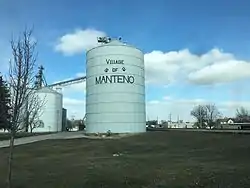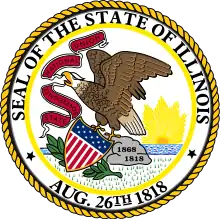Manteno, Illinois
Manteno is a village in Kankakee County, Illinois, United States. The population was 9,204 at the 2010 census,[4] up from 6,414 at the 2000 census. It is part of the Kankakee-Bourbonnais-Bradley Metropolitan Statistical Area.
Manteno, Illinois | |
|---|---|
 | |
| Motto(s): "Village of Values and Opportunities"[1] | |
 Location of Manteno in Kankakee County, Illinois | |
.svg.png.webp) Location of Illinois in the United States | |
| Coordinates: 41.250129°N 87.838282°W | |
| Country | United States |
| State | Illinois |
| County | Kankakee |
| Township | Manteno |
| Government | |
| • Mayor | Timothy Nugent |
| Area | |
| • Total | 5.36 sq mi (13.88 km2) |
| • Land | 5.33 sq mi (13.79 km2) |
| • Water | 0.03 sq mi (0.09 km2) |
| Elevation | 688 ft (210 m) |
| Population (2010) | |
| • Total | 9,204 |
| • Estimate (2019)[3] | 9,002 |
| • Density | 1,690.20/sq mi (652.61/km2) |
| Time zone | UTC-6 (CST) |
| • Summer (DST) | UTC-5 (CDT) |
| Area code(s) | 815/779 |
| FIPS code | 17-46500 |
| Website | www |
History
Origins of village name
Manteno was named after Manteno (Mawteno), a daughter of Francois Bourbonnais, Jr. (thus her grandfather was the man for whom the city of Bourbonnais was named) and his Potawatomi wife.[5] A Potawatomi name, it is a possible anglicization of manito or manitou, a Potawatomi word for "spirit".[6] Oliver W. Barnard, an early settler in this area, spelled her name "Mantenau" in one of his books. Other 19th century books spell it "Mawteno" and "Manteno".
Because she was a Métis, Manteno (spelled "Monteno" in the treaty, but considered incorrect, as the clerk also misspelled "Bourbonnais") was given a section of land, now part of northeastern Kankakee County, by the treaty of Treaty of Tippecanoe on December 20, 1832.
Incorporation
Both Kankakee and Iroquois counties were part of Will County, Illinois, before the State Legislature granted a plea of Kankakee's citizens and permitted them to incorporate in 1853.
The present township of Manteno was then the east half of the township of Rockville. On March 12, 1855, the town's petition that the area become the township of Manteno was granted by the county's board of supervisors.
The village was incorporated on July 8, 1878.[7]
Oktoberfest
Manteno is famous for having its beautiful festival every late September. People come to Manteno from miles around to attend Oktoberfest. The village has many family oriented activities as well as adult musical entertainment from many well known local bands.
Geography
Manteno is located in northern Kankakee County at 41°15′0″N 87°50′18″W (41.250129, -87.838282).[8] It is bordered to the south by the village of Bourbonnais. The average elevation is 675 ft (206 m).
Interstate 57 passes through the west side of the village, with access from Exit 322. I-57 leads south 10 miles (16 km) to Kankakee, the county seat, and north 47 miles (76 km) to Chicago. Illinois Route 50 passes through the center of Manteno as Locust Street and leads north 6 miles (10 km) to Peotone and south 8 miles (13 km) to Bradley.
According to the 2010 census, Manteno has a total area of 5.014 square miles (12.99 km2), of which 4.98 square miles (12.90 km2) (or 99.32%) are land and 0.034 square miles (0.09 km2) (or 0.68%) are water.[9]
Demographics
| Historical population | |||
|---|---|---|---|
| Census | Pop. | %± | |
| 1880 | 632 | — | |
| 1890 | 627 | −0.8% | |
| 1900 | 932 | 48.6% | |
| 1910 | 1,229 | 31.9% | |
| 1920 | 1,182 | −3.8% | |
| 1930 | 1,149 | −2.8% | |
| 1940 | 1,537 | 33.8% | |
| 1950 | 1,789 | 16.4% | |
| 1960 | 2,225 | 24.4% | |
| 1970 | 2,864 | 28.7% | |
| 1980 | 3,155 | 10.2% | |
| 1990 | 3,488 | 10.6% | |
| 2000 | 6,414 | 83.9% | |
| 2010 | 9,204 | 43.5% | |
| 2019 (est.) | 9,002 | [3] | −2.2% |
| U.S. Decennial Census[10] | |||
As of the census[11] of 2000, there were 6,414 people, 2,578 households, and 1,789 families residing in the village. The population density was 2,143.0 people per square mile (828.2/km2). There were 2,750 housing units at an average density of 918.8 per square mile (355.1/km2). The racial makeup of the village was 97.79% White, 0.27% African American, 0.17% Native American, 0.20% Asian, 0.02% Pacific Islander, 0.98% from other races, and 0.58% from two or more races. Hispanic or Latino of any race were 2.82% of the population.
There were 2,578 households, out of which 32.5% had children under the age of 18 living with them, 57.8% were married couples living together, 8.7% had a female householder with no husband present, and 30.6% were non-families. 25.6% of all households were made up of individuals, and 9.6% had someone living alone who was 65 years of age or older. The average household size was 2.48 and the average family size was 3.00.
In the village, the population was spread out, with 26.3% under the age of 18, 7.3% from 18 to 24, 30.3% from 25 to 44, 21.6% from 45 to 64, and 14.5% who were 65 years of age or older. The median age was 36 years. For every 100 females, there were 97.5 males. For every 100 females age 18 and over, there were 93.4 males.
The median income for a household in the village was $48,599, and the median income for a family was $56,077. Males had a median income of $46,359 versus $25,675 for females. The per capita income for the village was $22,826. About 3.9% of families and 5.3% of the population were below the poverty line, including 5.8% of those under age 18 and 3.9% of those age 65 or over.
Economy
Manteno is located approximately 50 miles (80 km) south of Chicago's loop. There is a combination of industrial and agricultural employers in town. Farmers Elevator Company of Manteno stands as the tallest site in town, with the ability to house 2 million bushels of corn or soybeans at any one time.[12]
Manteno is home the Diversatech Industrial Park is on the east side of town. It contains many diversified industrial plants and warehousing complexes.
Manteno State Hospital, one of the largest psychiatric hospitals in the country when it opened in 1928, was located 2 miles (3 km) southeast of the village. It received its first patients in 1930 and closed in 1985. That closure and the 1983 closure of Hilman Hospital, a general medical hospital, brought economic stagnation to the town. The north half of the original campus of the state hospital has been turned into a veterans' home. Some buildings have been torn down and housing has been put up. A lot of the buildings have been renovated, and very few buildings on the south side of the campus are left in original condition, but are still abandoned.
Although the village once had direct access to Chicago via a commuter line, that railroad hasn't operated since the 1920s. The Metra Electric station in University Park, 16 miles (26 km) north of Manteno, is the closest rail access.
Education
Manteno Public Schools are part of the Manteno Community Unit School District 5. The district has an elementary school, middle school and high school. Students attend Manteno High School.[13] The schools together have about 2,200 students.
Notable people
- Fred Sylvester Breen, Arizona newspaper editor and politician, born in Manteno
- Adam Kinzinger, U.S. Representative for Illinois's 16th congressional district; lives in Manteno
- George R. Lawrence, photography and aviation pioneer; lived in Manteno and is buried there
- John Moisant, aviator, lived in Manteno
- Charles A. Spring, Presbyterian leader and son of Samuel Spring; helped establish the First Presbyterian Church of Manteno (1859)
References
- "Village of Manteno, Illinois". Village of Manteno, Illinois. Archived from the original on August 20, 2012. Retrieved August 31, 2012.
- "2019 U.S. Gazetteer Files". United States Census Bureau. Retrieved July 14, 2020.
- "Population and Housing Unit Estimates". United States Census Bureau. May 24, 2020. Retrieved May 27, 2020.
- "Geographic Identifiers: 2010 Demographic Profile Data (G001): Manteno village, Illinois". American Factfinder. U.S. Census Bureau. Retrieved February 15, 2019.
- "Profile for Manteno, Illinois, IL". ePodunk. Retrieved August 31, 2012.
- Illinois Central Magazine. Illinois Central Railroad Company. 1922. p. 45.
- "Manteno, Illinois". City-data.com. Retrieved August 31, 2012.
- "US Gazetteer files: 2010, 2000, and 1990". United States Census Bureau. 2011-02-12. Retrieved 2011-04-23.
- "G001 - Geographic Identifiers - 2010 Census Summary File 1". United States Census Bureau. Archived from the original on 2020-02-13. Retrieved 2015-10-26.
- "Census of Population and Housing". Census.gov. Retrieved June 4, 2015.
- "U.S. Census website". United States Census Bureau. Retrieved 2008-01-31.
- Tabern, Robert; Tabern, Kandace (December 9, 2016). Outside the Rails: A Rail Route Guide from Chicago to Carbondale, IL (First ed.). Outside the Rails Books. ISBN 9781365214295.
- "Manteno Community Unit School District 5". Manteno Community Unit School District 5. Retrieved August 31, 2012.
External links
| Wikimedia Commons has media related to Manteno, Illinois. |

